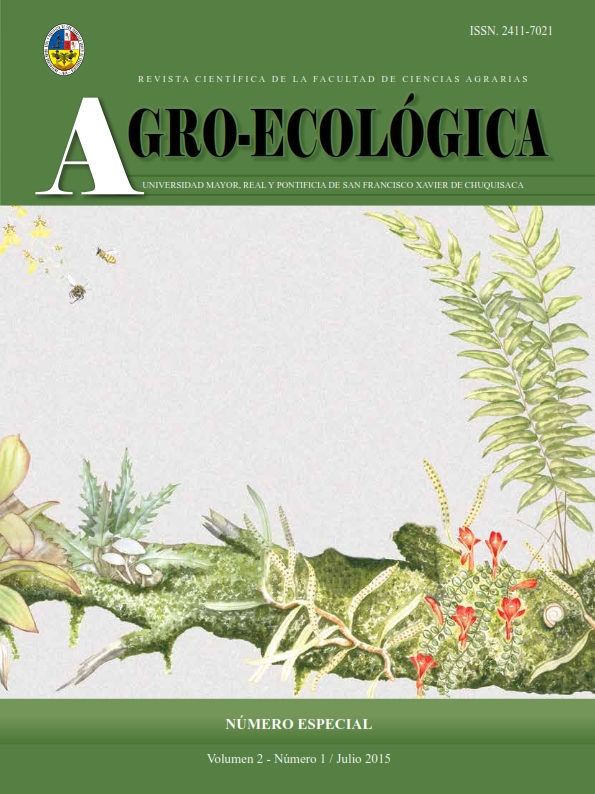Recuperación de la fertilidad de suelos en bosques secundarios, Monteagudo - Chuquisaca
DOI:
https://doi.org/10.56469/rae.v2i1.89Keywords:
restauración, Edad del bosque, materia orgánica, sucesión vegetalAbstract
Los bosques secundarios juegan un papel importante en la recuperación de la fertilidad de suelos, sobre todo en aquellas regiones donde se practica la agricultura migratoria no sustentable de rosa-tumba y quema, en la cual la tierra se cultiva por periodos cortos bajando su rendimiento y productividad. Se evaluó el proceso de recuperación de las propiedades edáficas en distintas edades de bosques secundarios estratificados en cuatro sucesiones: bosque inicial (BI) 1-7 años, bosque medio (BM) 8-13 años, bosque maduro (BMa) 14-25 años y bosque tardío (BT) > 25 años. La evaluación se llevó a cabo en la comunidad de Zapallar del Parque Nacional y Área de Manejo Integrado Serranía del Iñao, Bolivia, donde se seleccionaron 20 sitios, con 4 puntos de muestreo por sitio a una profundidad de 0-5 cm. Los resultados se analizaron mediante pruebas ANOVA, test de medias de Tukey (a< 0,05) para evaluar la relación entre edad del bosque y variables indicadoras de calidad de suelo se utilizó análisis de regresión. Los resultados indicaron que dentro y entre sitios existe alta variabilidad en la textura, materia orgánica y otras propiedades del suelo. La relación de MO y la edad del BS (R²=0,45) fue significativo (p=0, 001) mientras que el P disponible y N total no fue significativo. Entonces se concluye que los contenidos de MO y otros micronutrientes aumentan conforme avanza la edad del bosque secundario en una misma clase textural.
References
Alfaro, E. A., Alvarado, A. & Chaverri, A. (2001). Cambios edáficos asociados a tres etapas sucesionales de bosque tropical seco en Guanacaste, Costa Rica. Agronomía Costarricense, 25(1), 7-20.
An, S. S., Huang, Y. M. & Zheng, F. L. (2009). Evaluation of soil microbial indices along a revegetation chronosequence in grassland soils on the Loess Plateau, Northwest China. Applied Soil Ecology, 41(3), 286-292. https://doi.org/10.1016/j.apsoil.2008.12.008
Anderson, J. & Swift, M. (1983). Descomposition in tropical forest. En S. Sutton, T. Whitmore & A. Chadwick (Eds.), Tropical rain forest: ecology and management (pp. 287-309). Blackwell Scientific Publications.
Bautista, A., Del Castillo, R. & Gutiérrez, C. (2003). Patrones de desarrollo del suelo asociados con sucesión secundaria en un área originalmente ocupada por bosque mesófilo de montaña Instituto de Recursos Naturales, colegio de postgraduados. Montecillo-México. 5-6.
Bertrand, I., Holloway, R.E., Armstrong, R.D. & McLaughlin, M.J. (2003). Chemical characteristics of phosphorus in alkaline soils from southern Australia. Australian Journal of Soil Research, 41(1), 61-76. https://doi.org/10.1071/SR02021
Brown, S. & Lugo, A. (1982). The storage and production of organic matter in tropical forests and their role in the global carbon cycle. Biotropica, 14(3), 161-187. https://doi.org/10.2307/2388024
Buol, S.W. (1994). Environmental consequences: Soils. En W.B. Meyer & B.L. Turner (Eds.), Changes in land use and land cover: A global perspective (pp. 211-229). Cambridge University Press.
Ceccon, E., Olmsted, I. & Campo, J. (2002). Vegetación y propiedades del suelo en dos bosques tropicales secos de diferente estado regeneracional en Yucatán. Agrociencia, 36(5), 621-631.
Chang, Q.R., An, S.S., Liu, J., Wang, B. & Wei, Y. (1999). Study on benefits of recovering vegetation to prevent land deterioration on Loess Plateau. Journal of Soil Erosion and Soil and Water Conservation, 5(4), 6-9.
Dixon, R.K., Brown, S., Houghton, R.A., Solomon, A.M., Trexler, M.C. & Wisniewski, J. (1994). Carbon pools and flux of global forest ecosystems. Science, 263(5144), 185-190. https://doi.org/10.1126/science.263.5144.185
Febles, J.M., Vega, M.B., Febles, G., Tolón, A. & Jerez, L. (2007). Criterios de selección para determinar valores umbrales de sostenibilidad de los suelos en áreas piloto de la Habana, Cuba. Presentado en el I Seminario de cooperación y desarrollo en espacios rurales Iberoamericanos. Sostenibilidad e indicadores.
Feldpausch, T.R., Rondon, E.C., Fernandes, E., Riha, S.J. & Wandelli, E. (2004). Carbon and nutrient accumulation in secondary forests regenerating on pastures in central Amazonia. Ecological Applications, 14(4), 164-176. https://doi.org/10.1890/01-6015
Fonseca, W., Benayas, J.M.R. & Alice, F.E. (2011). Carbon accumulation in the biomass and soil of different aged secondary forests in the humid tropics of Costa Rica. Forest Ecology and Management, 262(8), 1400-1408. https://doi.org/10.1016/j.foreco.2011.06.036
Fu, B.J., Wang, J., Chen, L.D. & Qiu, Y. (2003). The effects of land use on soil moisture variation in the Danangou catchment of the Loess Plateau, China. Catena, 54(1-2), 197-213. https://doi.org/10.1016/S0341-8162(03)00065-1
Galdo, I.D., Six, J., Peressotti, A. & Cotrufo, M.F. (2003). Assessing the impact of land-use change on soil C sequestration in agricultural soils by means of organic matter fractionation and stable C isotopes. Global Change Biology, 9(1), 1204-1213. https://doi.org/10.1046/j.1365-2486.2003.00657.x
Golley, F. (1983). Descomposition. En Tropical rain forest ecosystems: estructura and functions (pp. 117-136). Elsevier.
Griscom, H.P. & Ashton, M.S. (2011). Restoration of dry tropical forests in Central America: A review of pattern and process. Forest Ecology and Management, 261(10), 1564-1579. https://doi.org/10.1016/j.foreco.2010.08.027
Guo, L.B. & Gifford, R.M. (2002). Soil carbon stocks and land use change: a meta-analysis. Global Change Biology, 8(4), 345-360. https://doi.org/10.1046/j.1354-1013.2002.00486.x
Huntington, T.G. & Ryan, D.F. (1995). Whole-tree-harvesting effects on soil nitrogen and carbon. Forest Ecology and Management, 31(1-3), 193-204. https://doi.org/10.1016/0378-1127(94)03205-M
Ichikogu, V.I. (2012). Total nitrogen and available phosphorus dynamics in soils regenerating from degraded abandoned rubber plantation in orogun area of the rainforest zone of Southern Nigeria. Ethiopian Journal of Environmental Studies and Management, 5(1.
Jiao, F., Wen, M.Z. & Shan, A.S. (2011). Changes in soil properties across a chronosequence of vegetation restoration on the Loess Plateau of China. Catena, 86(2), 110-116. https://doi.org/10.1016/j.catena.2011.03.001
Kauppi, P.E., Mielikäinen, K. & Kuusela, K. (1992). Biomass and carbon budgets of European forests. Science, 256(5053), 70-74. https://doi.org/10.1126/science.256.5053.70
Lovich, J.E. & Bainbridge, D. (1999). Anthropogenic degradation of the Southern California Desert ecosystem and prospects for natural recovery and restoration. Environmental Management, 24(3), 309-326. https://doi.org/10.1007/s002679900235
Matsumoto, L.S., Martinesa, A.M., Avanzia, M.A., Albino, U.B., Brasil, C.B., Saridakis, D.P., Rampazo, L.G., Zangaro, W. & Andrade, G. (2005). Interactions among functional groups in the cycling of carbon, nitrogen and phosphorus in the rhizosphere of three successional species of tropical woody trees. Applied Soil Ecology, 28(1), 57-65. https://doi.org/10.1016/j.apsoil.2004.06.009
McLaughlin, J.W. & Phillips, S.A. (2006). Soil carbon, nitrogen, and base cation cycling 17 years after whole-tree harvesting in a low-elevation red spruce (Picea rubens)-balsam fir (Abies balsamea) forested watershed in central Maine, USA. Forest Ecology and Management, 222(1-3), 234-253. https://doi.org/10.1016/j.foreco.2005.10.033
Quiroga, A.R., Buschiazzo, D.E. & Peinemann, N. (1998). Management Discriminant properties in Semiarid Soil. Soil Science, 136(7), 1266-1279.
Resh, S.C., Binkley, B. & Parrotta, J. (2002). Greater Soil Carbon Sequestration under Nitrogen-fixing Trees Compared with Eucalyptus Species. Ecosystems, 5(3), 217-231. https://doi.org/10.1007/s10021-001-0067-3
Ritchie, J.C. & McCarty, G.W. (2003). Using Cesium to understand soil carbon redistribution on agricultural watersheds. Soil and Tillage Research, 69(1-2), 45-51. https://doi.org/10.1016/S0167-1987(03)00062-0
Rivera, J.H., Amaríz, M.F. & Álvarez, W.R. (1986). Plan de uso, manejo y conservación de los suelos del centro experimental Cotové. Universidad Nacional de Colombia, Medellín.
Scott, A.J. & Morgan, J.W. (2012). Recovery of soil and vegetation in semi-arid Australian old fields. Journal of Arid Environments, 76, 61-71. https://doi.org/10.1016/j.jaridenv.2011.08.014
Sedjo, R.A. (1992). Temperate forest ecosystems in the global carbon cycle. Ambio, 21(4), 274-277.
Soto, M.M., Arbelaez, A., Pérez, G.A. & Raciny, L.C. (1986). Levantamiento semi-detallado de los suelos de la finca Paysandú. Universidad Nacional de Colombia, Medellín.
Stolte, J., Van, V., Zhang, B.G., Trouwborst, K.O., Liu, G., Ritsema, C.J. & Hessel, R. (2003). Landuse induced spatial heterogeneity of soil hydraulic properties on the Loess Plateau in China. Catena, 54(1-2), 59-75. https://doi.org/10.1016/S0341-8162(03)00056-0
Tisdale, S., W. Nelson, J. Beaton & J. Havlin. 1993. Soil Fertility and fertilizers, ed: Macmillan Publishing Company. Vol. 10: 364-404.
Wang, G.L., Liu, G.B. & Xu, M.X. (2002). Effect of vegetation restoration on soil nutrient change in Zhifanggou watersheds of loess hilly region. Bulletin of Soil and Water Conservation, 22, 1-5.
Wang, Y., Fu, B., Lü, B. & Chen, L. (2011). Effects of vegetation restoration on soil organic carbon sequestration at multiple scales in semi-arid Loess Plateau, China. Catena, 85(1), 58-66. https://doi.org/10.1016/j.catena.2010.12.003
Zhang, J.H., Liu, S.Z. & Zhong, X.H. (2005). Distribution of soil organic carbon and phosphorus on an eroded hillslope of the rangeland on the northern Tibet Plateau, China. European Journal of Soil Science, 57(3), 365-371. https://doi.org/10.1111/j.1365-2389.2005.00747.x
Zhang, J.H., Quine, T.A., Ni, S.J. & Ge, F.L. (2006). Stocks and dynamics of SOC in relation to soil redistribution by water and tillage erosion. Global Change Biology, 12(10), 1834-1841. https://doi.org/10.1111/j.1365-2486.2006.01206.x
Zou, X. & Bashkin, M. (1997). Soil carbon accretion and earthworm recovery following revegetation in abandoned sugarcane fields - Puerto Rico. Soil Biology and Biochemistry, 30(6), 825-830. https://doi.org/10.1016/S0038-0717(97)00155-7




